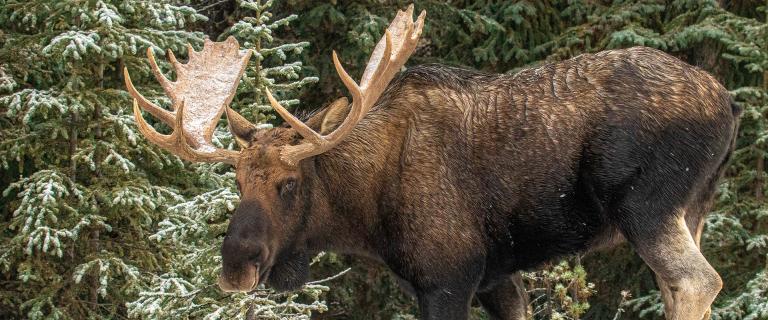
Repopulating Endangered Animals Can Play a Vital Role in Cutting Carbon Emissions
Rewilding, restoring, and conserving endangered and threatened species could magnify carbon uptake by 1.5 to 12.5 times or more across the world.

Rewilding, restoring, and conserving endangered and threatened species could magnify carbon uptake by 1.5 to 12.5 times or more across the world.
As climate leaders gather at COP26 in Glasgow and negotiate actions to keep global temperature rise under the tipping point of 1.5 degrees Celsius there is one natural carbon solution not getting enough attention — rewilding, says Yale School of the Environment Oastler Professor of Population and Community Ecology Os Schmitz. From elephants to whales to wildebeest to wolves, animals can play a vital role in carbon drawdown.
Schmitz is helping to lead efforts to draw attention to the potential for supercharging ecosystem carbon sinks with a coalition of 60 scientists, economists, and civic organizations as part of a new initiative by the Global Rewilding Alliance.
We have to draw out a significant amount of CO2 and store it on the planet to stabilize the temperature. Animals can help us get to this goal a lot faster.”
“Even if we could completely stop all our emissions tomorrow, switched to renewables, and stopped deforestation, it wouldn’t be enough. We still have a big enough volume of CO2 in the atmosphere that would lead us to overshoot the 1.5-degree limit,’’ says Schmitz. “We have to draw out a significant amount of CO2 and store it on the planet to stabilize the temperature. Animals can help us get to this goal a lot faster.”
Rewilding, restoring, and conserving the role of species could magnify carbon uptake by 1.5 to 12.5 times or more across the world’s terrestrial, freshwater, and marine ecosystems, the coalition notes in a statement sent to COP26 leaders.
“If we’re going to solve the climate crisis, and meet the 1.5 Celsius target, the Global Rewilding Alliance believes it is necessary to urgently supercharge ecosystem carbon sinks through animating the carbon cycle. This needs to be recognized by UNFCC and other global processes,’’ said Global Rewilding Alliance member Vance Martin, who is president of the WILD Foundation, a global conservation organization based in Boulder, CO.
Schmitz’s research into the science known as “animating the carbon cycle” has found that animal activity, such as foraging, redistributing seeds and nutrients over lands and seascapes, and trampling and compacting soil sediments enhances carbon density.
The Serengeti is one example. In that region, the restored wildebeest population has enabled the ecosystem to move from being a carbon source to a carbon sink that now takes up an additional 8 million tons of carbon annually, offsetting the annual CO2 emissions of Kenya and Tanzania combined, according to a 2014 study “Animating the Carbon Cycle” by Schmitz published in the journal Ecosystems.
The same study also found that protecting wolf populations and the trophic cascades they initiate that limit the density and behavior of their moose prey in the boreal forests of North America can contribute to the uptake of 150 million extra tons of carbon annually, offsetting 10% of U.S. carbon emissions.
If elephants, which once numbered more than 1.1 million in the central African Congo Basin, again roamed the rainforests there, an additional 85 million tons of carbon would be naturally stored each year, which is the equivalent of France’s annual CO2 emissions, a study by Fabio Berzaghi published in 2019 in Nature GeoScience found. This massive additional carbon storage would occur because elephants eat the understory of trees, which is the underlying layer of vegetation in a forest or wooded area. This highly efficient pruning allows overstory trees, which are trees with the highest level of vegetation in a forest that form the canopy, to thrive, capture carbon better, and increase the forest’s carbon density.
Marine life also has a huge role to play in carbon capture and sinks. The excrement of whales provides nutrients for phytoplankton to flourish, which naturally suck carbon from the atmosphere. Restoring the whale population to near-historic levels has the potential to stimulate the take up of an additional 450 million tons of ocean carbon per year, capturing the annual emissions of Russia, according to a 2021 study.
“It’s always been presumed these threatened and endangered animals are so rare that they can’t have a big impact, so they don’t get factored into the carbon budget. But what’s been ignored is the multiplier effects that modify how plants take up carbon and how soil stores carbon. It really requires a paradigm change,’’ says Schmitz.
Rewilding can prevent massive CO2 releasing wildfires, protect against the thawing of permafrost, and can enhance soil and sediment carbon retention through chemical reactions and microbial processes, his research has found.
Schmitz, along with YSE post-doctoral fellow Elisabeth Forbes and Memorial University Professor Shawn Leroux, will be undertaking experimental research across a rewilded landscape in Newfoundland, exploring how moose hunting and wildlife management can be aligned with strategies to enhance carbon uptake and storage.
Rewilding and restoration on a significant scale will require efforts to build trust with local communities to find ways to let animals roam more freely and in larger numbers. Community members would have to be compensated for helping to protect biodiversity so that their livelihoods would not be threatened.
Ultimately the bigger challenge is that carbon markets do not pay for rewilding efforts, Schmitz says.
“We don’t put a value on that aspect of the long-term benefit of nature and human well-being,’’ he says. “We really need to think about new ways of financing animal management and conservation for this purpose. We need to create mechanisms that help finance the stewardship and caring of wild animals in support of natural carbon solutions.”
Photo Caption:
Moose browsing in a boreal forest in Canada in winter 2021. Moose can impact plant uptake of carbon and soil carbon storage by feeding on vegetation, trampling soils and, recycling nutrients from body wastes. Credit — Coulter Schmitz